By Kurt Waltenbaugh
The last 15 years have seen steady, continual growth in both Medicare Advantage (MA) enrollment and the number of payers offering MA health plans. Yet much of that growth has gone to handful of large, national vendors—UnitedHealthcare, Humana, the Blues, CVS-Aetna—that control nearly 70% of the market (see Figure 1 and Figure 2).
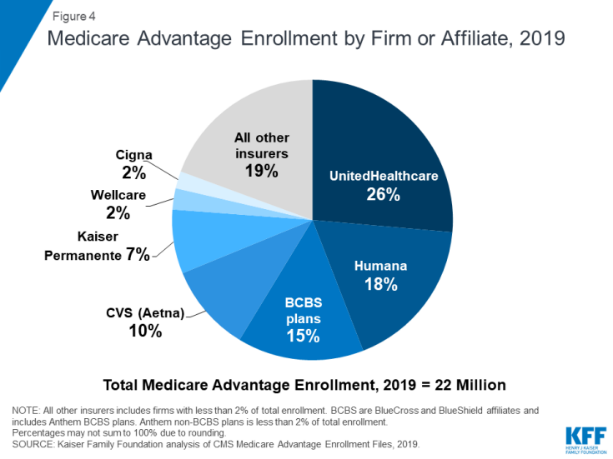
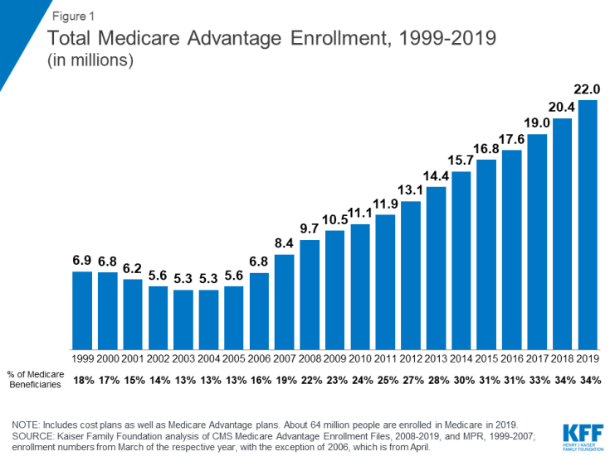
(Source: https://www.kff.org/medicare/issue-brief/a-dozen-facts-about-medicare-advantage-in-2019/)
Carrot Health has been analyzing its robust database of consumer information to explore how behavior is changing in light of the pandemic and—dare we imagine—the post-pandemic world. This data guides us to an understanding of what consumers need and how to connect with them in five key areas:
- 2021 AEP in a presidential election year
- Loss of in person events
- Financial challenges
- Health challenges
- Increased community need (i.e. an SDoH crisis)
What the Data Says
What does the data tell us about how seniors might change their behavior, post-pandemic? It tells us what we need to create a well-informed strategy that evaluates the experiences of history, and projects new behaviors based on a broad set of consumer experiences.
Carrot Health continually reaches out to seniors, asking them questions about their behavioral and motivations—how do they feel and respond? We currently are in the field researching how the COVID-19 crisis might affect senior health care decision making during 2020 enrollment, and beyond.
The stakes—1/3 of seniors are not currently satisfied with their Medicare health plan’s response to COVID-19, and a growing group (17%) indicate they may be willing to switch plans as a result. How do we manage this risk, this opportunity?
In short, post-pandemic, seniors are going to be hard to reach. As reliable voters in a hotly contested presidential election year, advertising options will be both expensive and of limited value.
Seniors especially will not be attending in-person events during 2020, nor will they sit down face-to-face with brokers in their homes. Media consumption patterns are changing, the longer we “shelter in place” the more these changes become engrained habits. Shifts away from print news media and radio to broadcast, cable, and broadband television will accelerate. That, coupled with the loss of in-person event options, means plans will have to get creative to reach potential new members, and they will need to prepare for a lower response rate than realized in prior years.
Transportation and driving patterns are also changing as people increasingly look for local options. This spills over into network design for Medicare Advantage plans, as seniors become less tolerant of any driving distance for care and highly tuned to local options. Carrot Health’s research confirms this—40% of seniors identify easy access to local urgent care/clinics/hospitals as “much more important” in their decision-making process, along with making sure their primary care physician is in-network.
In terms of financial challenges, there is no one-size-fits-all universal financial situation. Some seniors are very well insulated from the economic issues facing the working population. Others will be highly impacted. Almost every senior will have a younger family member who is facing economic difficulty for years to come. Knowing which of these seniors you are talking to is critical to making the appropriate offers.
Further, based on our analysis of prior recessions, seniors will spend less. They will reduce savings and cut back on medical spend to make ends meet. For the population nearing retirement, they bifurcate into two paths: those who retire early (either by choice or necessity) and those who delay retirement due to financial constraints. Of those who extend their time in the workforce, they will do so on average by four years. Carrot Health research confirms: 1 in 10 of those not retired expect to work longer than planned before retirement, and a small but sizeable cohort of currently retired seniors plan on returning to work.
With economic and physical health so inextricably linked, we expect seniors to have more medical risk in the coming years due to declines in medication adherence, increased stress due to finances, and social isolation and loneliness increase. Mental and behavioral health needs will increase as depression and cognitive function loss rise.
These impacts are felt at varying rates. Communities that were disadvantaged to begin with will be impacted at much great rates than others. These social and behavioral disparities—the social determinants of health (SDoH)—present barriers that become insurmountable in troubling economic times as less resilient communities and individuals have the greatest needs.
Drilling Down
AEP 2021 and the Election Year Impact: This is the presidential election year to end all presidential election years in recent history. Political “noise” will drown out most Medicare advertising “signals” during the key annual enrollment period—especially in key presidential battleground markets. In the last presidential election cycle, political advertising crowded out almost every other form of advertising during the final three weeks of the election, which overlaps with the heaviest enrollment period. As a result, the 2017 AEP was the lowest net MA enrollment growth of the previous five years. We expect 2021 to be similar.
Further, healthcare issues are hot election debate topics – big issues which may cause many seniors to delay purchasing a plan until after the election is decided. Projections call for $6 billion in political media spending for 2020 (see Figure 3 and Figure 4); $4.4 billion in traditional media (broadcast TV, cable, radio) buys and $1.6 billion in digital video (Facebook & Google)—figures that represent massive increases from 2016 and 2018.

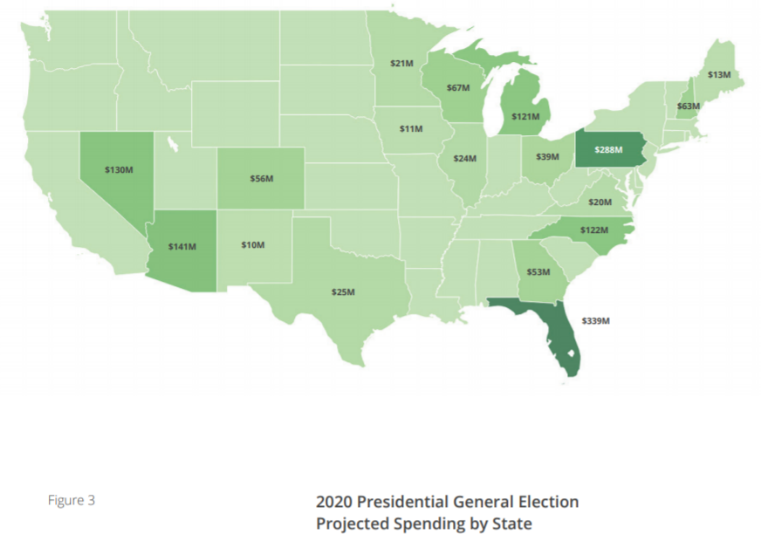
(Source: https://www.politico.com/f/?id=0000016b-b029-d027-a97f-f6a95aca0000)
The Absence of In-Person Events: 45% of AEP takes place during peak presidential election advertising. In some of the swing states, there will be zero available advertising space on TV. As reliable voters, seniors are prime targets for political advertising and increasingly harder to reach. Exacerbating the impact is the reality that there will be no in-person events, regardless of whether the economic environment is open or closed. We suspect that most seniors will simply not take in-person meetings or attend public gatherings.
The inability to connect through the two primary methods for reaching seniors—broadcast and in-person events—we envision more reliance on 1:1 outreach and highly targeted methods such as direct mail. Pay attention to the political cycle and geography, as campaigns at all levels also rely on direct mail, which can result in very full mailboxes.
Financial Uncertainty: There is no “one-size-fits-all” senior when it comes to financial situations. Knowing which category the senior you’re trying to reach falls into is critical to getting the message right.
Uncertainty rules the day. When the future is uncertain, as it is for 2020, major life decisions are put on hold. We see more seniors delaying purchasing decisions until late in the process and an increase in those who “default” by making no choice. This will result in an increase in OEP activity in early 2021.
Frugality will also take center stage. Even if they have significant assets, most seniors will be nervous about the decline in the value of those assets due to the financial crisis and news reports. Individuals who lose jobs or wealth will in turn reduce spending to make up for the financial shortfall. For those on the margins, this may require a dramatic shift in their spending abilities in a potentially dire way.
As a result, several patterns are expected to emerge:
• Early/forced retirement (layoffs) resulting in lower spending ability for duration of retirement
• Delayed retirement due to decline in wealth, meaning those who are able will choose to work on average four years longer.
For health plans, this means an increased number of seniors qualifying for dual-eligible plans as assets are exhausted, and an acceleration of the trend towards zero-dollar plans as a driving criterion for plan selection. Plans will also see an increase in populations delaying Medicare choice until after age 65 (e.g. 66-70) and declines in spend on medical care, with a significant drop in medication adherence.
Health Uncertainty: These financial hardships have a direct impact on health. Many seniors are affected by rising unemployment, decline in stock values, and reduced home equity. Almost all seniors also have family members who are financially impacted. In fact, research suggests that job loss later in life is correlated with a negative impact on physical and mental health. Mental health concerns including stress, depression, cognitive decline, and substance abuse are especially increased.
The tendency to forego or ration medical care to reduce expenses, coupled with the reduction in “elective” procedures due to 2020 shelter-in-place requirements, will improve medical loss ratios in the short term. Claims are already dropping and will continue to do so. Due to the stability of Medicare, this is less pronounced in senior populations than commercial, but still significant.
Based on our analysis of prior recessions, this reduction in near-term spend will result in an increased future burden on medical need. These are long term trends, with significant impacts to medical spend expected over the next 10 years.
Increased Community Need: Financial and health impacts accrue at uneven rates. Seniors who were already struggling will find it even harder to recover.
This highlights the fundamental issue with social and behavioral risk factors, or SDOH. What was previously a cause for concern will now be in full-on crisis. Those already at risk for housing instability, food insecurity, and loneliness are less likely to recover swiftly in the post-pandemic world. Carrot Health research (see Figure 5 and Figure 6) demonstrates the link between critical infection risk due to COVID-19 and the correlation with the overwhelming burden of needs upstream of the health system. Those most impacted are often the least resilient.
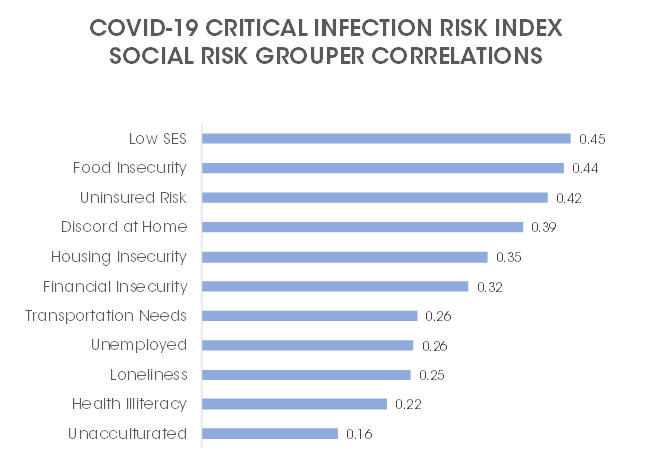

Those with higher needs may gravitate to lower cost plans and increase the demand for original Medicare and dual-eligible programs.
In Conclusion
To better understand the risk faced in a community, we must start with the individual. There is no “one-size-fits-all” approach. Analysis at the individual person level will help uncover the unique fingerprint of risk faced by each geography, each book of business, and each patient panel.
Combining that individual risk with an understanding of the evidence presented by behavior during and after prior public health and economic crises allows us to chart a course for recovery, and plan for a better future for the people in our care.
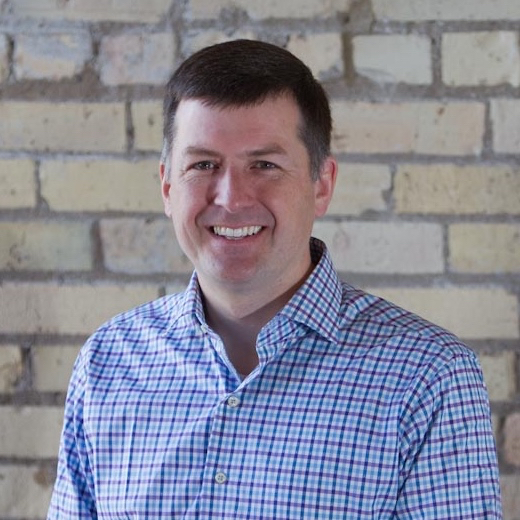
Kurt Waltenbaugh is Founder & Chief Executive Officer of Carrot Health (www.carrothealth.com), a leading provider of healthcare solutions powered by social determinants of health (SDoH).
